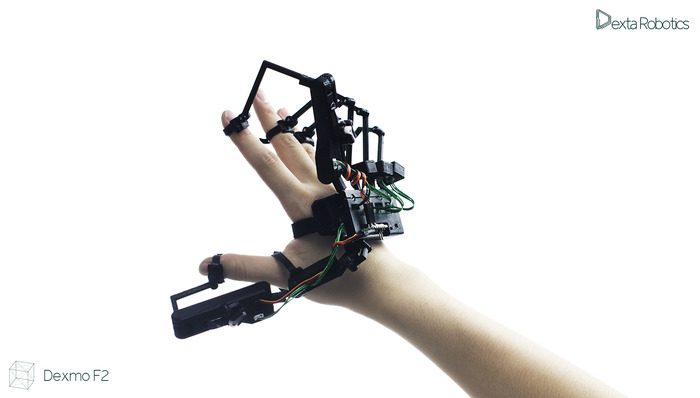Dexta Robotics today launched a Kickstarter campaign for their VR input device known as Dexmo, a mechanical exoskeleton glove designed for VR input and which offers users force feedback.
VR Input and Output in Once Device

With the debut of Oculus’ latest feature prototype dubbed ‘Crescent Bay’ at the recent Oculus Connect conference, the general feeling is that the VR company is close to nailing the hard problems associated with displaying virtual worlds and fusing low latency head tracking to deliver an experience that can induce presence in its user. The big question at that event was actually over the ever growing issue surrounding how you interact with these convincingly realised virtual worlds. But beyond VR input devices, how do you then give a person in VR tactile information on the world they’re in?
Dexta Robotics think they have part of the answer. It’s called the Dexmo and it’s an intriguing device for VR enthusiasts. The company has announced the launch of that product’s Kickstarter campaign which will give enthusiasts early access to a device that not so long back would have been considered a work of science fiction.

Dexta Robotics, a Chinese startup firm born in March of this year, was founded to bring this new product to life. After iterating through some 17 prototypes, the company have decided to release the Dexmo in two versions via a new Kickstarter campaign with a goal of $200k, according to the company.
Dexmo Kickstarter
The Dexmo comes in two flavours, the Dexmo Classic and F2. The Classic is purely an input device which uses IMUs attached to each of your fingers and thumb to detect movement of the articulated links to each digit plus rotational input from the thumb. It can detect both the splitting (when you separate your fingers) and bending of your fingers plus 3 degrees of movement (rotational) of the thumb. The F2 adds digital force feedback for both your index finger and thumb, meaning that onboard servos ‘brake’ your movement according to information pulled from a VR experience. The upshot is that you can virtually ‘feel’ an object when your hand comes into contact with it.
Neither version of the device offers any form of spatial or rotational tracking that is, it has no idea where your hand is in 3D space. The team instead plan to encourage the use of 3rd party IMUs such as the Sixense STEM system to provide these extra degrees of input. It’s important to note here that force feedback is not only limited to your thumb and index finger, but there is no analogue feedback supplied—the finger ‘braking’ is purely binary, on or off. This does limit the gloves uses for interactive experiences where nuanced feedback would be required. It’s still a pretty impressive feat of engineering though and a step in the right direction.
What do I Get For My Money?
The entry level pledge which gives you an actual device starts at $75 for a single Classic Dexmo exoskeleton, with a pair requiring a pledge of $150. A single F2 with force feedback costs $179 and $319 for a pair. All hardware pledges also come with access to the company’s SDK and Arduino library. Arduino is an open source software platform designed to interface with robotic devices such as the Dexmo.
It’s all incredibly interesting and another example of a far eastern company managing to spin up designs and prototypes for a futuristic device in an amazingly short period. It’s also an important step in the direction of providing VR users sensory input to seal the sense of presence when interacting with virtual spaces. We’re very much looking forward to seeing what comes of the Dexmo and wish the team the best of luck with their campaign.
You can back the Dexmo Kickstarter right here and you can find more information on Dexta at their website here.







